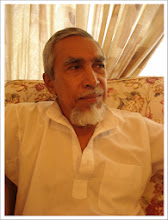1. If you were to wander around the old part of
George Town, the capital of Penang, you would possibly come across one of the
oldest roads in the city, Chulia
Street. In the 19th
century, the road used to be part of the enclave of Tamil Muslim traders where
businesses throve.
2. In 1786, Captain Francis Light acting for
the East India Company established a British settlement at the eastern tip of Penang island
facing the mainland. The new port had attracted the influx of immigrants seeking
greener pastures, particularly from southern India.
3. The South Indian immigrants from the
Coromandel and Malabar coasts settled along a road built by the British as
early as the development of the port itself. It was initially named Malabar
Street but later changed to Chulia Street because at that time Europeans used
the term Chulia or Chulier for South Indians, the family roots on my father’s side.
4. My great-grandfather, Mohamed Merican Noordin, the patriarch of the Noordin family, was
a prominent Chulia merchant during the first three decades of the 19th century
until his death in 1870. His mausoleum is situated in Chulia Street in the
vicinity of the famous Kapitan Kling Mosque.
5. My grandfather, Vapoo Merican Noordin, the eldest son of Mohamed Noordin, was a merchant in his
own right. He established his own company under the name V. M. Noordin around
mid-1800s and ran his business in Chulia Street until his unexpected death in
1884.
6. Vapoo left two sons; Mohamed Hussain,
probably a young man at the time of his death, and Mohamed Ismail, then aged
two. The latter, who was my father, left George Town towards the end of 1910
aged 28 to make a name for himself as a civil servant in Alor Star.
7. Apparently, my father’s emigration had affected
his relationships with close relatives over time. I only have very dim
childhood memories of occasional trips to Penang to visit his relatives but
nothing really come to pass. I was nine when he passed away in 1956 and for us,
namely my siblings and I, it marked the end of family ties with his side.
8. When he died, my father took the Noordin
lineage with him. Thus my siblings and I were severed from the merchant
lineage. However, I knew that my father was well remembered by his younger
relatives; probably his nephews or nieces or more likely their children.
9. For instance, there was a piece of comment I read on the internet in praise of my father written by
someone who claimed to be his nephew. And in another instance, my father’s services
as a civil servant under the government of Kedah were highlighted in a blog
on the history of the Noordin family.
10. It was an irony of life that my father didn’t
have any children from his earlier marriages
and only be blessed with a firstborn in his mid-60s after marrying my mother.
They got a second child about a year later and a third and the last child when
he was 68. 14. I suppose that’s the way the cookie crumbles.
11. I guess the youngest of my cousins, if any
of them are still alive, would be octogenarians by now. The older ones would be
nonagenarians or centenarians. In actual fact, their children and I very
probably belong in the same age group.
12. And there is off course the question of paternity that has arisen from a simple matter
of variations in the spelling of names in our vital records. On account of the
mistakes, I had to submit a statutory declaration form in order to obtain a
copy of my father’s death certificate.
13. Despite the anomalies, I am fortunate
enough to become aware of my paternity during the first nine years of my life.
14. I suppose that’s the way the cookie crumbles.











No comments:
Post a Comment